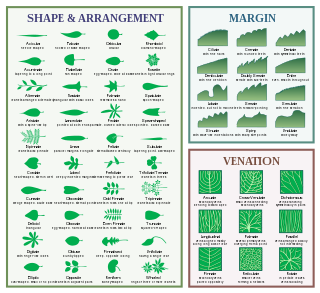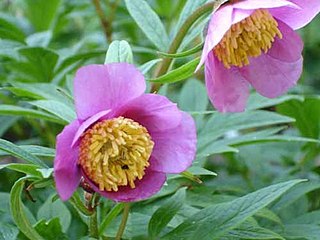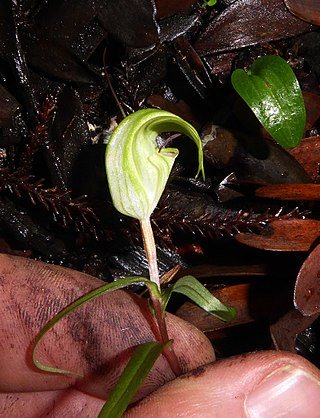
Plant reproductive morphology is the study of the physical form and structure of those parts of plants directly or indirectly concerned with sexual reproduction.

The following is a list of terms which are used to describe leaf morphology in the description and taxonomy of plants. Leaves may be simple or compound. The edge of the leaf may be regular or irregular, may be smooth or bearing hair, bristles or spines. For more terms describing other aspects of leaves besides their overall morphology see the leaf article.

Commelinaceae is a family of flowering plants. In less formal contexts, the group is referred to as the dayflower family or spiderwort family. It is one of five families in the order Commelinales and by far the largest of these with about 731 known species in 41 genera. Well known genera include Commelina (dayflowers) and Tradescantia (spiderworts). The family is diverse in both the Old World tropics and the New World tropics, with some genera present in both. The variation in morphology, especially that of the flower and inflorescence, is considered to be exceptionally high amongst the angiosperms.

Parnassiaceae Gray were a family of flowering plants in the eudicot order Celastrales. The family is not recognized in the APG III system of plant classification. When that system was published in 2009, Parnassiaceae were treated as subfamily Parnassioideae of an expanded family Celastraceae.

Hibbertia, commonly known as guinea flowers, is a genus of flowering plants in the family Dilleniaceae. They are usually shrubs with simple leaves and usually yellow flowers with five sepals and five petals. There are about 400 species, most of which occur in Australia but a few species occur in New Guinea, New Caledonia, Fiji and Madagascar.

Paeonia brownii is a low to medium height, herbaceous perennial flowering plant in the family Paeoniaceae. It has compound, steely-gray, somewhat fleshy leaves and small drooping maroon flowers. Its vernacular name is Brown's peony, native peony or western peony. It is native to the western United States and usually grows at altitude, often as undergrowth in part-shade. The fleshy roots store food to carry the plant through the dry summers and produce new leaves and flowers the following spring.

A flower, sometimes known as a bloom or blossom, is the reproductive structure found in flowering plants. The biological function of a flower is to facilitate reproduction, usually by providing a mechanism for the union of sperm with eggs. Flowers may facilitate outcrossing resulting from cross-pollination or allow selfing when self-pollination occurs.

Ixerba brexioides, the sole species in the genus Ixerba, is a bushy tree with thick, narrow, serrated, dark green leaves and panicles of white flowers with a green heart. The fruit is a green capsule that splits open to reveal the black seeds partly covered with a fleshy scarlet aril against the white inside of the fruit. Ixerba is an endemic of the northern half of the North Island of New Zealand. Common names used in New Zealand are tawari for the tree and whakou when in flower. It is assigned to the family Strasburgeriaceae.
This page provides a glossary of plant morphology. Botanists and other biologists who study plant morphology use a number of different terms to classify and identify plant organs and parts that can be observed using no more than a handheld magnifying lens. This page provides help in understanding the numerous other pages describing plants by their various taxa. The accompanying page—Plant morphology—provides an overview of the science of the external form of plants. There is also an alphabetical list: Glossary of botanical terms. In contrast, this page deals with botanical terms in a systematic manner, with some illustrations, and organized by plant anatomy and function in plant physiology.
Tetrachondra is a plant genus and a member of the family Tetrachondraceae. It comprises two species of creeping succulent, perennial, aquatic or semi-aquatic herbaceous plants. Its distribution range is disjunct: one species is endemic to New Zealand while the other one is endemic to southern Patagonia and Tierra del Fuego. These plants bear essential oils.
This glossary of botanical terms is a list of definitions of terms and concepts relevant to botany and plants in general. Terms of plant morphology are included here as well as at the more specific Glossary of plant morphology and Glossary of leaf morphology. For other related terms, see Glossary of phytopathology, Glossary of lichen terms, and List of Latin and Greek words commonly used in systematic names.

Paeonia veitchii is a species of herbaceous perennial peony. The vernacular name in China is 川赤芍. This species is ½-1 m high, has a thick irregular taproot and thin side roots, and deeply incised leaves, with leaflets themselves divided in fine segments. It has two to four fully developed flowers per stem, that may be pink to magenta-red or rarely almost white. It is known from central China.

Paeonia delavayi is a low woody shrub belonging to the peonies, that is endemic to China. The vernacular name in China is 滇牡丹. In English it is called Delavay's tree peony, Delavay peony, Dian peony, and dian mu dan. It mostly has red brown to yellow, nodding flowers from mid May to mid June. The light green, delicate looking deciduous leaves consist of many segments, and are alternately arranged on new growth.

Paeonia ludlowii, is a medium high, deciduous shrub, belonging to the peonies, that is endemic to southeast Tibet. In Tibet it is known as lumaidao meaning "God’s flower". The vernacular name in Chinese is 大花黄牡丹 meaning "big yellow-flowered peony". In English it is sometimes called Tibetan tree peony or Ludlow's tree peony. It has pure yellow, slightly nodding, bowl-shaped flowers, and large, twice compounded, light green leaves.

Paeonia anomala is a species of herbaceous perennial peony. This plant is ½-1 m high, with a thick irregular taproot and thin side roots. The deeply incised leaves have leaflets which are themselves divided in fine segments. It flowers in early summer, almost always with only one fully developed flower per stem, magenta-red or rarely pink or white. The species occurs in a zone between northern European Russia and northern Mongolia and south to the Tien Shan Mountains.

In botany, a whorl or verticil is a whorled arrangement of leaves, sepals, petals, stamens, or carpels that radiate from a single point and surround or wrap around the stem or stalk. A leaf whorl consists of at least three elements; a pair of opposite leaves is not called a whorl.

Cartonema is a genus of perennial or annual monocotyledonous flowering plants in the dayflower family. It is restricted to Australia and nearby Trangan Island, which is part of Indonesia. It is the earliest diverging member of its family and has a number of traits that are unique within it, such as non-succulent leaves and a lack of raphides. Its distinctive features led to the genus to once be considered part of its own separate family, Cartonemataceae. However, analysis of DNA sequences, as well as many common anatomical characters, has supported its relationship with the Commelinaceae. It contains about 11 species.

Strasburgeriaceae is a small family of flowering plants in the order Crossosomatales, only found in New Zealand and New Caledonia. It contains two genera, Strasburgeria and Ixerba. Both genera have simple, evergreen, alternated leaves, often in worl-like clusters, with gland-tipped serrations, hermaphroditic, pentamerous flowers with persistent sepals, clawed petals, flat and long filaments that extend beyond the petals and a persistent style with a punctiform stigma.

Teucrium racemosum, also commonly referred to as either the grey germander or forest germander, is a species of flowering plant in the family Lamiaceae. It is endemic to Australia and is found in all mainland states, the Northern Territory and the Australian Capital Territory. It grows in floodplains, dry lake beds and open woodlands. A perennial herb, it has four-sided, densely hairy stems, narrow egg-shaped leaves, and white flowers usually arranged singly in leaf axils. It grows to be between 15 and 40 cm tall.

Pterostylis brumalis, commonly known as the kauri greenhood or winter greenhood, is a species of orchid endemic to New Zealand. There is a rosette of leaves at the base of both flowering and non-flowering plants. Flowering plants have a white flower with narrow green stripes and a dorsal sepal which bends forward strongly while the petals spread widely, giving the flower a cobra-like appearance.
















